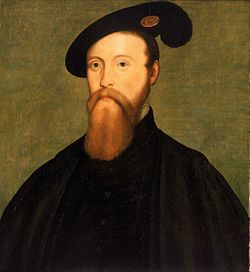
This day marked the beginning of the fall of Thomas Seymour, a man of great hubris. Though truth be told, he had started on the path some time before.
To use the words of Sir Nicholas Throckmorton, Thomas Seymour was “hardy, wise and liberal … fierce in courage, courtly in fashion, in personage stately, in voice magnificent, but somewhat empty of matter.” His brother Edward was more dour and serious. As the oldest brother in the Seymour family, Edward benefited more than Tom when their sister Jane married Henry VIII and gave birth to his son and heir. At the time of the marriage, Edward Seymour was named Viscount Beauchamp of Hache, Thomas was made a gentleman of the Privy Chamber (Edward already was one). When the future Edward VI was born, Edward Seymour became the Earl of Hertford, Thomas was knighted. Then when Henry VIII died, Edward took the real prize: he upset the terms of Henry’s will to become Lord Protector of England, and gave himself the title of Duke of Somerset. Thomas became Baron of Sudeley, a step up from a plain knight, but not yet even an earl.
Thomas Seymour had bigger plans for himself. He knew he was Edward VI’s favorite uncle (he was the fun one who gave him money) and did his best to translate that to power. Then he married Katherine Parr, Henry VIII’s widow and the new King’s stepmother. Together they formed a couple with a powerful ability to influence the King (though Katherine lost a great deal of respect because the marriage occurred less than six months after Henry’s death). The marriage intensified the rivalry between the brother for several reasons. First, Katherine had expected that Henry would appoint *her* Regent during Edward VI’s minority – that’s what Henry had done when he left on his military campaign to France between July and September 1544 – so she had a bit of a falling out with Edward Seymour. Then Anne Seymour, Edward’s wife, argued with her over who was to be allowed to wear the queen’s jewels. Katherine of course believed that as Queen Dowager she should have that right until a new queen was in place – but Anne Seymour argued that as the wife of the Lord Protector, they should be hers until Edward VI married. Anne won.
That background may help contextualize the jealousy and bitterness that propelled Thomas Seymour to a foolhardy plan (it may also explain why Edward Seymour let his brother be executed after he was arrested). But it doesn’t make Thomas’ next actions any less ridiculous.
Within weeks of Henry VIII’s death, Thomas Seymour had tried unsuccessfully to marry one of his daughters before wooing Katherine Parr. So it was an awkward situation when Katherine took on Elizabeth’s guardianship and had the fourteen year old princess come live in their home. Horseplay followed, and Katherine even joined in at first, but it went further than that. Thomas Seymour would come to Elizabeth’s bedchamber in his nightshirt and bare feet to wake her up in the mornings, tickling her until she screamed for her ladies. After several weeks of this, a heavily pregnant Katherine caught the two of them in an embrace and Elizabeth was sent away in disgrace. On August 30, 1548, Katherine gave birth to a baby girl, then died six days later of puerpural fever, also called childbed fever (a relatively common issue of the day). During her periods of delirium, she accused Thomas of wishing her dead and suggested that he had in fact poisoned her.
It was after her death that Thomas Seymour seemed to become a bit unhinged. He continued to foment opposition to his brother – both with his nephew and the Council. He tried to create rebellion: he bribed Sir William Sharington, the Vice-Treasurer of the Bristol Mint, to secure financing for his plans, and he used his position as Lord High Admiral to seek support from the Royal Navy (he also turned a blind eye to pirates along the coast who paid him for his leniency and promised their own support). Finally, on January 16, 1549, Thomas Seymour went too far. In the middle of the night, he tried to break into the sleeping King’s apartments at Hampton Court Palace. He made it into the privy garden (he had keys), but one of the King’s pet spaniels started barking, and he shot and killed it. When that brought guards running, he blustered some excuses and unbelievably was allowed to go home. But there was no excuse for being outside the King’s bedroom in the middle of the night with keys and arms – and using them both. Different versions of his motivation were proposed (it was alleged that he had a priest in his home ready to marry the King to Jane Grey and himself to Elizabeth) but they all suggested treasonable intent.
The morning of the 17th, Thomas was arrested and brought to the Tower. The Council also quickly started to question everyone associated with him, including Elizabeth. On February 22, 1549, they finally charged Seymour with 33 counts of treason.
He was executed on March 20, 1549.
***
If you like my posts, you’ll love my books! My Seymour Saga trilogy tells the gripping story of the short-lived dynasty that shaped the Tudor Era. Jane the Quene skews romantic, The Path to Somerset is pure Game of Thrones (without the dragons), and The Boy King is a noir coming-of-age. Get them now through Amazon, Barnes & Noble, Kobo, and Apple, or even your local independent bookstore!

(PS Already read them? Did you love them? Then please review them – even just a stars rating! It makes a huge difference in helping new readers find them and would mean the world to me!)

[…] January 17, 1549 – Thomas Seymour Arrested for Treason. […]
[…] back to Tom Seymour. In another blog post (here), I describe his crime: breaking into a sleeping Edward VI’s bedchamber in the middle of the […]
Oops, you make me feel confused. The date in the headline says January 17, 1549. That was exactly 470 years ago from today.
But in the text you write ” …finally, on December 16, 1549 … the morning of the 17th, Thomas was arrested. ..”
But he was executed in March, 1549…
Oof! Fixed it! not sure where the December date came from…
[…] birth to a daughter, Mary, who likely died around age 2. Thomas followed his wife to the grave seven months later, dying on a scaffold at the Tower for such treasonous acts as plotting to kidnap the king and […]